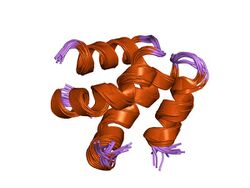Biology:Ectatomin
| Ectatomin | |||||||||
|---|---|---|---|---|---|---|---|---|---|
 ectatomin (water solution, nmr 20 structures) | |||||||||
| Identifiers | |||||||||
| Symbol | Ectatomin | ||||||||
| Pfam | PF06457 | ||||||||
| InterPro | IPR009458 | ||||||||
| SCOP2 | 1eci / SCOPe / SUPFAM | ||||||||
| OPM superfamily | 74 | ||||||||
| OPM protein | 1eci | ||||||||
| |||||||||
Ectatomin is a protein toxin from the venom of the ant Ectatomma tuberculatum. Ectatomin can efficiently insert into the plasma membrane, where it can form channels. Ectatomin was shown to inhibit L-type calcium currents in isolated rat cardiac myocytes.[1] In these cells, ectatomin induces a gradual, irreversible increase in ion leakage across the membrane, which can lead to cell death.
Ectatomin is composed of two subunits, A and B, which are homologous. The structure of ectatomin reveals that each subunit consists of two alpha helices with a connecting hinge region, which form a hairpin structure that is stabilized by disulfide bridges. A disulfide bridge between the hinge regions of the two subunits links the heterodimer together, forming a closed bundle of four alpha helices with a left-handed twist.[2]
References
- ↑ "Analysis of ectatomin action on cell membranes". Eur. J. Biochem. 262 (2): 501–6. June 1999. doi:10.1046/j.1432-1327.1999.00426.x. PMID 10336635.
- ↑ "Three-dimensional structure of ectatomin from Ectatomma tuberculatum ant venom". J. Biomol. NMR 5 (1): 1–13. January 1995. doi:10.1007/BF00227465. PMID 7881269.
 |

